#drawing dink like this was an experience and a half
Explore tagged Tumblr posts
Text

Life has many doors, Link-boy.
I feel like I need to apologize for this atrocity and repent for my sins lmao
(I also made this and I think it turned out nice enough)

#lu meme#lu#lu memes#lu shitpost#linked universe#linked universe memes#linked universe shitposts#dark link#lu dark link#lu dink#loz memes#im not sorry#drawing dink like this was an experience and a half#but I had fun creating this monstrosity#rip dink
70 notes
·
View notes
Text
Dark Link and Cowardice, part 4
This is part 4 of my LU theory. This theory had to be spread across four different posts thanks to Tumblr's image limit, all of which I will link to here. Part 4 is under the cut.
Part 1: Dink is a Coward Part 2: Cowardly Powers Part 3: Two Weapons Part 4: the Curse of Cowardice <—you are here
Part 4: the Curse of Cowardice
We've discussed how the curse of cowardice affected the Master Sword (or, rather, how it didn't). So let's switch gears and talk about how it affected Twilight.
When asked if any of the Links have allergies, Jojo responded with the following:
"Cowardice. It doesn't sit right with them."
At first I laughed this off. Okay yeah, of course the Heroes of Courage would despise cowardice, that just makes sense, right?
But then I remembered Twilight's symptoms. And Dink's behavior. And I realized that this answer was given not to the question of what the Links hate or dislike, but to the question of, "what are they allergic to". Suddenly what I thought was a silly quip seemed to be a lot more than that, and I found myself consumed with this idea and wondering, "Why didn't I see this before‽"
Immediately after being struck with the cursed blade, Twilight still seems to be relatively fine (as far as his courage goes, anyway). He repeatedly insists on returning to battle despite his grave injury; so far, so Link.

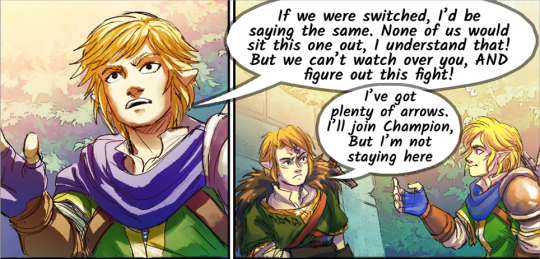
But by the time Four and Hyrule reach him in the village, his attitude is starting to nosedive; so much so that it just about offends Hyrule.

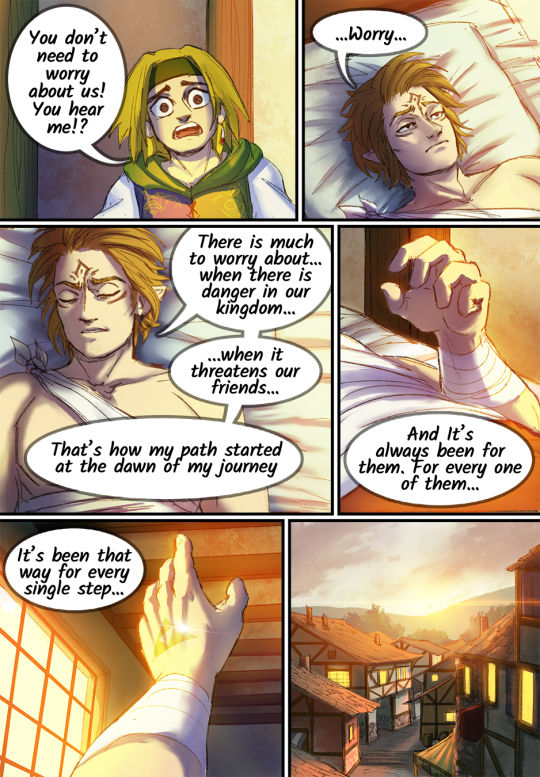
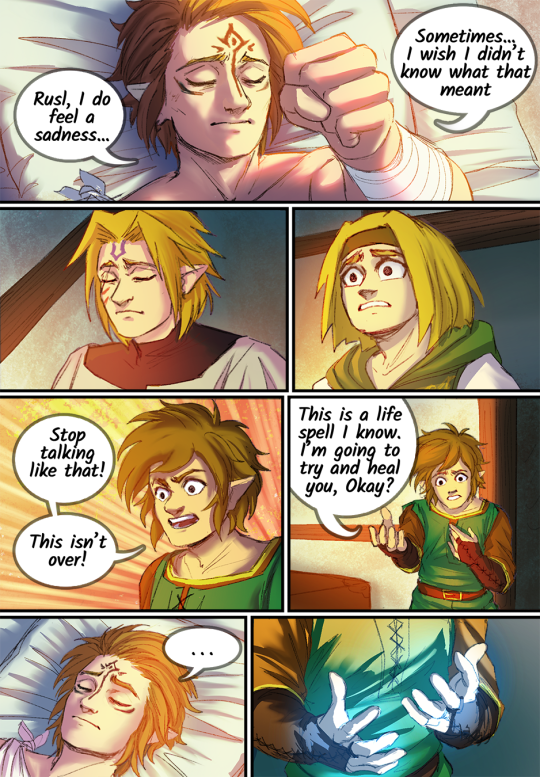
Notice the language Twilight's using here. He's starting to second-guess his motives for his journey, almost as if he's wondering if it was even worth it. He's placing the responsibility for his adventure on his friends, his loved ones, and everyone else who was in danger, rather than himself. He's beginning to sound like someone who doesn't believe they have control over their own fate.
This is the cowardice beginning to take hold.
By the time the rest of the gang gets there, he's gotten worse.

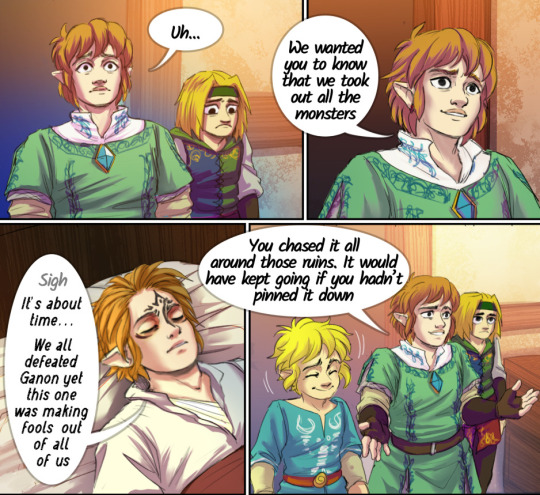
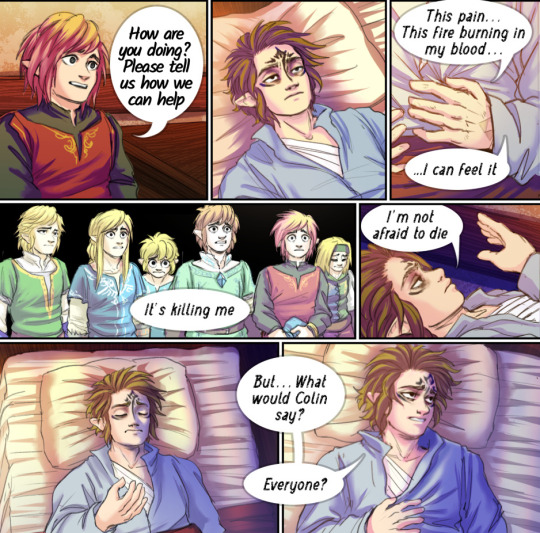
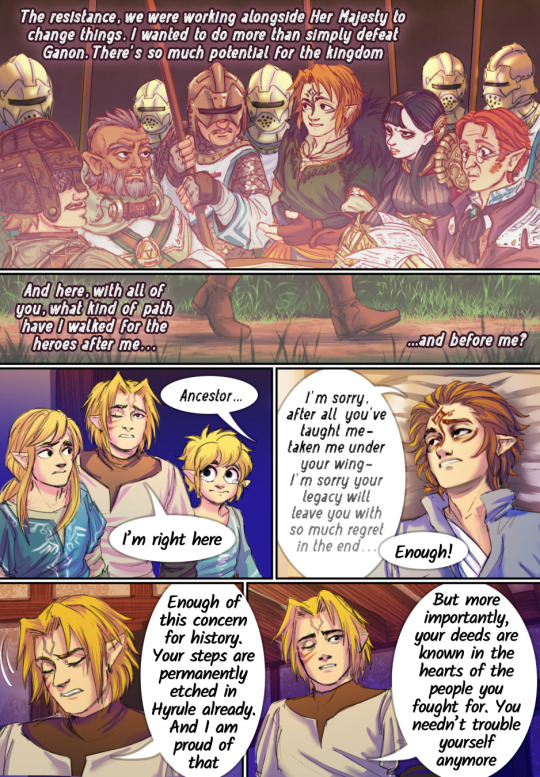
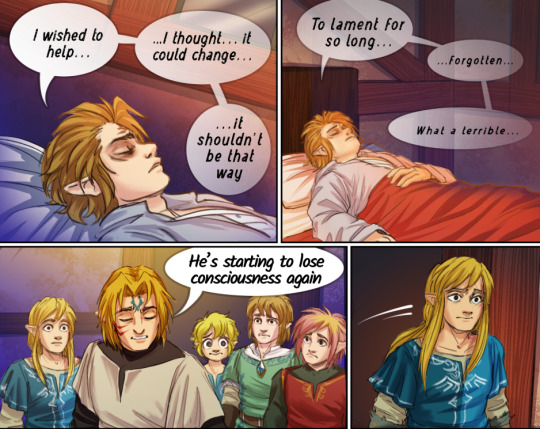
At first we get a few lines that establish that yes, this is still Twilight. We haven't lost him entirely as a person. And yet, the more he talks, the more hopeless he sounds. This man went from, "I'm not going to die from a scratch" to "I'm not afraid to die" in a matter of hours. And this is a Hero of Courage we're talking about, not some Joe Schmoe!
This goes to show just how potent this curse is, and how potentially deadly it is for a Link in particular. What these boys have been through would have broken the spirit of anyone else. This is a harrowing glimpse of what happens when the Hero's Spirit, the Spirit of Courage, is eroded by cowardice. Twilight refers to this as "divine courage" later, so it's implied that each of these boys understands just how uniquely powerful their courage is.
Thankfully, Twilight does not remain in this state. Once he's through the worst of it and is on the mend, this is how he describes the experience:
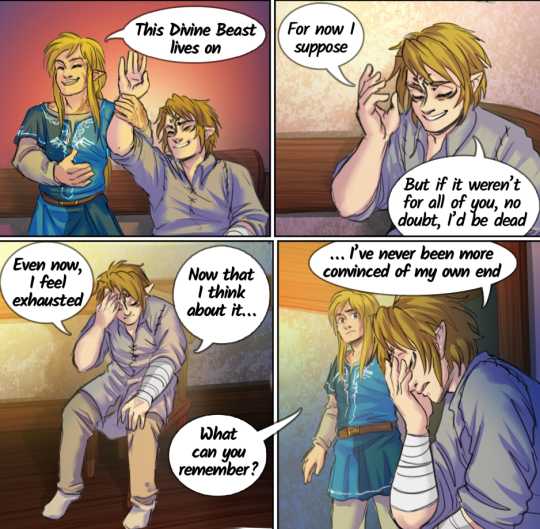
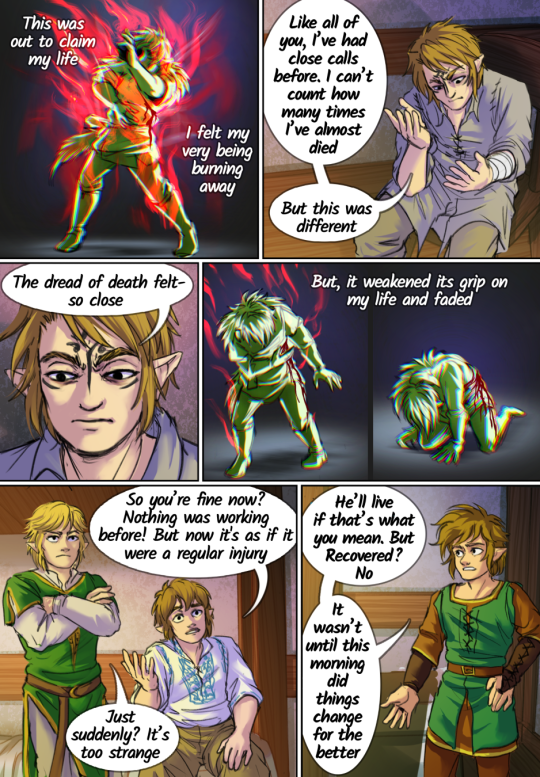
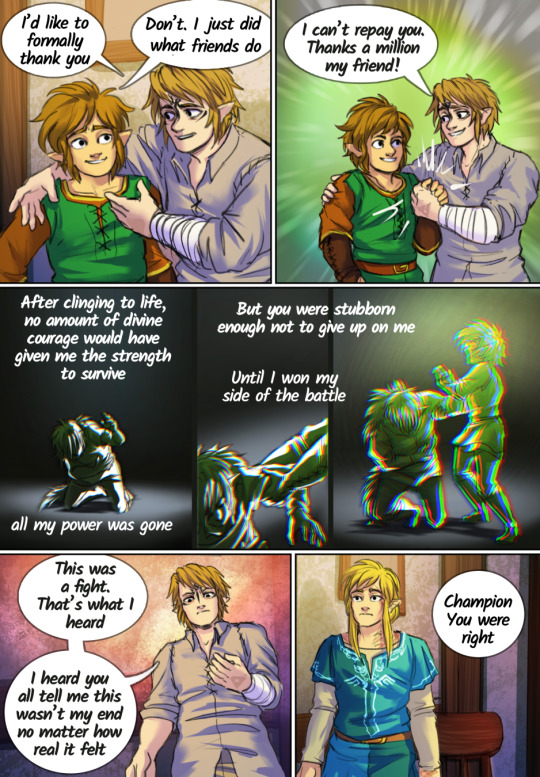
I find two things about this rather interesting. One, the curse weakened and let go of him on its own. I'll get to why I think this happened in a second. And two, once the curse fled, it was no longer courage that Twilight lacked—it was power.
These two things seem to confirm things that we already know about the Hero's Spirit, and that were brought up previously by various Links.
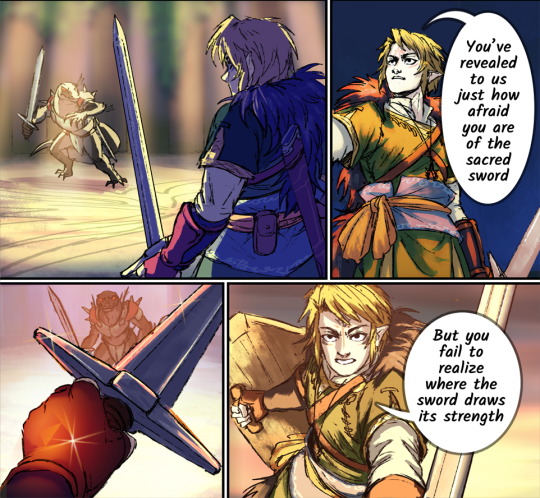
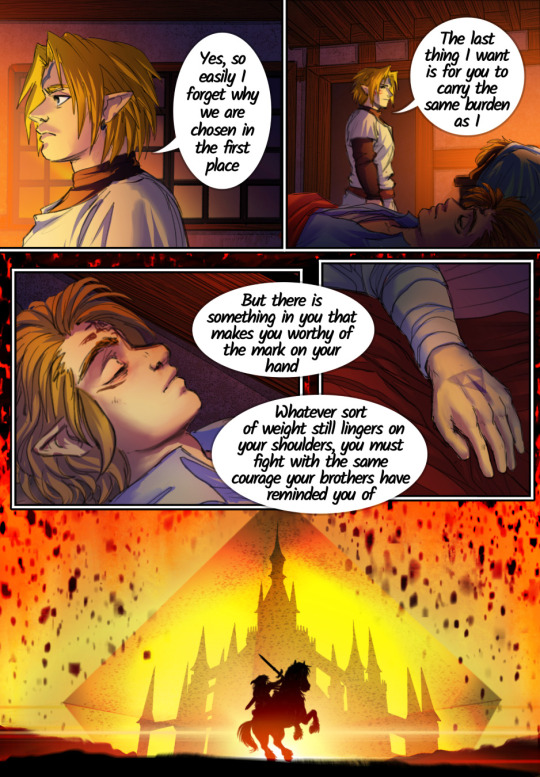
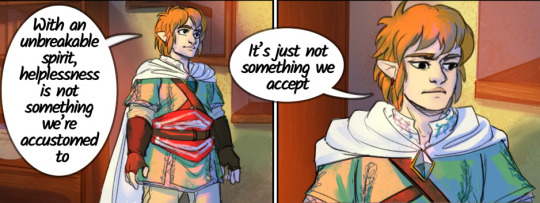
Here's what I think: Twilight was able to fight this curse in the first place because the Hero's Spirit is, by definition, unbreakable. Yes it was rocky; yes he wavered; but all it took was the stubbornness and encouragement of his friends to right his course, to convince him to keep fighting, even in his half-conscious state.
Many of the Heroes (all to some extent, but some more so than others) draw their strength and power primarily from their courage. Twilight is one of these. Hence, when the curse failed to deplete him of his courage entirely (see: unbreakable spirit), it instead held onto him long enough to siphon away all of the strength that he drew from his courageous heart. If it couldn't kill him by depriving him of his courage, then it would kill him by stealing his power instead.
Thankfully, his friends were there to lend him both their own courage and their strength in Twilight's time of need. Thus, the group as a whole is brought closer together, and they've learned valuable lessons about the seriousness of this threat, even if they don't quite understand how it operates yet.
It'll be interesting to see where things go from here. Ultimately this is just a fun theory and may or may not be what Jojo has in mind, but there's so much evidence for it that I had to throw it all together and share it with you guys. Thank you for sticking it out through multiple posts for this, I hope it was worth your time haha.
Take care everyone!
43 notes
·
View notes
Note
You should climb up to the height of your ego, then jump down head first to the level of your IQ
??????? That would mean I'd be flying up?? Are you telling me to grow wings or...????? My ego is like, to the floor and my IQ is well above average as tested by psychologists, so I'd be, again, going upwards.
I'm only answering this because I'm confused by the wording of this, it genuinely sounds more like a compliment and that you're telling me to fly and soar like the beautiful birdie I am :3 ❤️
If you're attempting to tell me to kill myself, I would actually suggest seeking a therapist if possible, instead. And/or getting a fun hobby. Mostly because I think you might have some internal stressors that are causing you to act out inappropriately to strangers you disagree with. Finding help for the stress in your life can actually feel so relieving! I know it's not always possible for everyone, especially if you live in the USA. But if you're able to, I think you would benefit from it, sincerely. It sounds like you might be going through some stuff.
If you want me to recommend some hobbies, here's a few that I like to do that you might enjoy! Things like customizing and cleaning up old Furbies, drawing, making shrinky dink Keychains, playing Dungeons & Dragons with friends, bird watching, going for walks, singing, baking, crafts like fursuit making, doll collecting, 3D avatar modeling and customization, fanfic writing, video games, etc.
If you want video game recommendations, I cannot express enough how much Cult of the Lamb is the best! I also would maybe try out games like Fallout (any really), Labyrinthine, Phasmophobia, Valheim, Slay the Princess, Crown of Leaves, Omori, Sketchy's Contract, Alice: Madness Returns, House Flipper, Indigo Park, Little Kitty / Big City, Passpartout 2: The Lost Artist, Little Nightmares, Borderlands (any really), The Murder of Sonic The Hedgehog, Sons of the Forest (or the original The Forest, or both), World of Horror, Content Warning, FOREWARNED, Lethal Company, Víscera Cleanup Detail, First Class Trouble, Hades, Half-Life, Outer Wilds, Resident Evil (any really), Stardew Valley, Animal Crossing, The Binding of Isaac, Death's Door, Changed, Hide and Shriek (if you have a friend to play with), In Sound Mind, Inscryption, Stray, We Happy Few, Don't Starve, Slime Rancher, Baldur's Gate 3, Dead By Daylight, Escape the Backrooms, On Dark Terms, We Need To Go Deeper, Rain World, What Remains of Edith Finch, Night in the Woods, and uhh Killer Frequency.
Let me know if you check out any of those games and like them, I love to hear about people's experiences! I hope you have a better day, or night depending on what timezone you are in ❤️
1 note
·
View note
Text
Author’s Notes: Chapter 24 (In The Eye Of The Beholder)
I was lucky enough to visit New York during late June this year, so a lot of this chapter is based on my own experiences. That scene in the opening of Sara being so preoccupied by taking pictures of everything she can that she almost walks into the street was not only a callback to chapter two, but also based off of an interaction I had with my dad while I was in NYC. I wasn’t taking pictures, I was recording everything around me, and I almost walked out into oncoming traffic before my dad grabbed my arm. Naturally, I scripted out that part of the chapter later that day.
Luckily the subway never flooded while we were there, but I have heard stories of that happening in the past. It’s not an unreasonable thing to happen.
I knew about a lot of New York’s staples before going on the trip, but what I wasn’t prepared for were all the unlicensed costume actors in Times Square. I’d never heard of that being a common thing. I went to Liverpool many years ago and there was a guy in an Easter Bunny costume that tried to steal my bag, but aside from that, I’ve never experienced anything like that. Originally, Hol Horse would’ve met up with Lovestrong in some isolated location (like a password-only bar) and he wouldn’t have been in a disguise, but after seeing all the costume actors myself I knew I had to riff on it somehow.
Believe it or not, the “shows what you know” line from Hol Horse went through a lot of revisions and was a major point of contention from some of the beta readers. It implies that Hol Horse isn’t actually his name, which ended up being a controversial talking point, made worse by the more straightforward wording of the original line. I won’t lie, part of me wanted to add that in because the issue of Hol Horse having a “real” name was such a major talking point between me and my beta readers (which I don’t see why, plenty of people headcanon that it’s an alias). I just wanted to have that in a chapter so we’d be forced to address it. It was also important to include so that plot element has been set up. We won’t see from it again for a while, but keep it in the back of your head going forward.
I’m sure many readers are wondering why Depeche would’ve left shards of Policy of Truth to all his henchmen in his will, and to that I say use your imagination! This is the kind of thing that I think is more fun to speculate on. I have my own reasoning for it, of course, but I encourage you to draw your own conclusions. I’m curious to see how others interpret this!
Lovestrong’s hatred of Stands was definitely a spur of the moment addition. I dinked around with the idea of him being a Stand user himself for a while, possibly to explain how he makes his passports, but I decided that it would make the story richer to show how people without Stands perceive Stand users. We don’t get a ton of that in JoJo, which is a shame. I think his contempt pairs well with Depeche’s envy.
This is yet another chapter that was originally meant to be longer but was cut in half. It wasn’t for length this time, but rather because the chapter’s two halves felt very disconnected from each other. Most of it has already been written though, so expect to see it within a week or so!
Music references:
None this time.
0 notes
Text
A Lesson Plan for Videogame Archaeology in the Museum
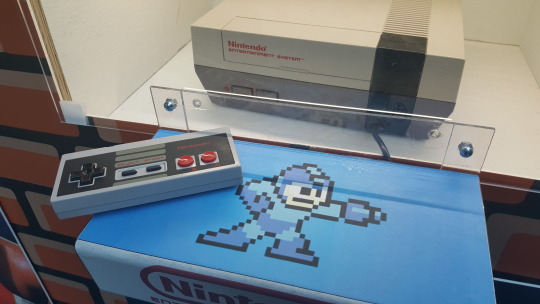
By Adrián Maldonado
I didn’t wake up that morning thinking I’d be playing an original Street Fighter II Championship Edition arcade console in just a few hours. It turned out to be a very good day.
So I was on Long Island recently for our annual, far-too-short family visit to America. It was also my daughter’s second birthday but it was raining and we needed an indoor activity. She loves planes, trucks and trains, and we were assured that the Cradle of Aviation Museum in Garden City has all that plus good hands-on activities and a toddler room. We were not disappointed on any of those fronts.
But unbeknownst to us, the Cradle of Aviation Museum also has a major videogame history exhibition on at the moment. And this was no ordinary rinky-dink travelling exhibit. I’m talking all the consoles, or at least 60 different ones, all playable, alongside some 30 original arcade cabinets. Whose birthday was it again?
It’s been a minute since my last post, so get ready for a nerd onslaught. This post will attempt three things: a straightforward review of a videogame history exhibit; some sense of the wider context within videogame museums I’ve been to recently; and finally, something a bit different: a lesson plan for teaching kids about videogames in the museum. I should probably change the blog title to Things No One Asked For, Ever, but in the meantime, do enjoy the blatant work avoidance.
Capsule review

This exhibit is actually a sequel. It began life as a temporary event called The Arcade Age in December 2015, which focused on recreating the experience of arcade gaming using some 50 playable cabinets. The recreated arcade was only accessible in three daily 90-minute sessions. The layout showed the influence of superhero arcadologist Raiford Guins, who was consulted for this exhibit, in its attention toward recreating the dark, cramped, noisy ambiance of an arcade. Judging by photos of the original exhibit, it also had a cool sideline on related material culture like Street Fighter II action figures and Pac-Man lunchboxes. It originally ran through April 2016, and was then extended to September 2016.
After its success, it was redesigned as a more comprehensive exhibition, From the Arcade to the Living Room: A Video Game Retrospective 1972-1999 in November 2016, now including a full history of home gaming consoles alongside a reduced but still impressive list of arcade cabinets. The website doesn’t say whether this will become a permanent exhibit, but they are selling season tickets for hardcore gamers until December 2017. It was this exhibition I stumbled upon one fateful day in June.

Wall of ancestors
The games are laid out in roughly chronological order, beginning with the carcass of a Computer Space cabinet from 1971 at the start. Curator Seamus Keane has been damn near exhaustive, going beyond the usual focus on ‘Golden Age’ arcade games and providing real working examples of lesser-performing systems like the Neo-Geo and the Atari Jaguar. Fulfilling the dream of a 90s indoor kid, it was perhaps the first and last time I’ll ever play a CD-I and a 3DO (note to me 25 years ago: neither was worth the wait).
Besides the snippets of information provided next to each console, historical context was a bit light and there was no clear aim or agenda for the exhibition. Media surrounding the opening fleshed it out a little more, but not much: for curator Keane, it was “a concept I had in my head of telling what I felt was somewhat of a lost history about the social culture and the popular culture, as well as the technological history of the arcade game itself and of the arcade as a social setting.” Hope you caught all that between rounds of Marvel Vs Capcom.
There were only a few thematic displays but they worked well – a wall of ephemera included a Nintendo Power Pad, several strategy guides and a Game Genie (!). A wall display on the Great Video Game Crash of 1983 included a screen playing the documentary Atari: Game Over (2014) next to an Atari 2600 with an ET cartridge you could load yourself, a crucial part of the home gaming experience you rarely get to experience in a museum setting. A cabinet of dead peripherals was also eye-opening in an unexpected way; the juxtaposition of Sega 3D Glasses and a Sega Dreamcast mouse from a decade apart made me think of how Sega was so often ahead of its time, and yet somehow lost the console wars. In the tech world, it doesn’t always pay to be first.
Videogames in the Museum

Touch the artefacts
I’ve been to several videogame museum exhibitions now (and even some videogame museums!) and can confidently say that this was one of the most fun. There was a wall of NES games and a wall of Atari games, but the core of the arcade was in a long, low-ceilinged dark hall. There, the half-assed display cards dwindled to a minimum and the game was the thing. Original cabinets, many of them with fucked-up decals from years of play, were ready to rock, no MAME here. Aside from the usual Golden Age of Arcade stuff, there were plenty of classic 90s cabinets from my era, and even some left-field entrants like Michael Jackson’s Moonwalker, which I thought was a masterpiece when I first played it in 1990 and has accrued tremendous baggage since then.
Best of all was the chronological row of home gaming consoles buried deep in the bunker-like arcade hall. Here in glowing cubicles of glass but not out of reach were the venerated SNES and Genesis games of my formative years, alongside the also-rans like the Sega Saturn. I showed my 2 year-old daughter her first game of Super Smash Bros for the N64. She picked up the control and held it up to her ear like a phone. I have never loved her more.
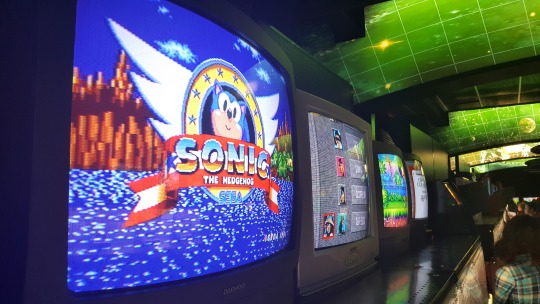
The ragtag army of 90s CRT veterans
Each console was hooked up to a full-on CRT TV, no messing about with flatscreens, as I’ve groaned about previously. As the exhibition website puts it, they are “all on old school TV tubes!” Each TV was different from the next one, as they had clearly been scavenged piecemeal from various Long Island attics. Some had flatter screens, some bulged out lewdly, but all were hard-bitten survivors from the 90s. They are the real heroes here.
How does this rate? While the Computerspielemuseum in Berlin clearly wins out in almost every way in terms of playability, historical context and design, there was something about the scale of the recreated arcade and lack of interpretation here that charmed me. As Guins has pointed out, the material presence of the cabinets and the consoles are part of the gameplay; they are designed to draw you in and beg you to grab them, and whatever their flaws, their physical interfaces shape how the game is played.
Beyond Retro-Nostalgia: A Lesson Plan
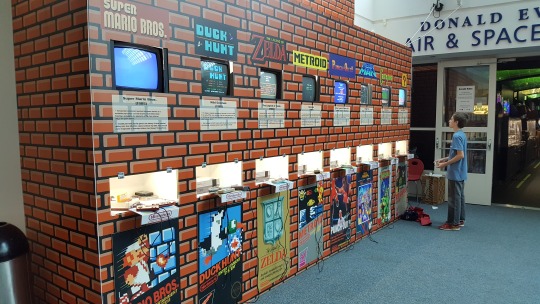
Ready player one
At one point I was able to play technician: I was able to revive a blank TV screen by switching it to channel 3. I felt like a wise elder. I also may have felt very old because I was surrounded by schoolkids. It was a weekday, and we shared the exhibit with a group of fifth-graders (Year 6 for UK readers). For once, it was genuinely interesting to share a museum with a school trip. There have always been children in the videogame exhibitions I’ve visited previously, but they’re always there with their aging nerd parents (of which I am now very much a number). It is certainly worth recording the stories told to a new generation about their cultural heritage. But it was enlightening in a different way to hear what kids said to one another when playing these games.
What I heard blew my mind. I was playing the Double Dragon (1987) arcade cabinet (I’d only ever played the NES version, so this was very exciting indeed), when two boys walked behind me – one of them said to the other, “Double Dragon! I love that game!” How did he know? What else did he know? Has the Internet already made everyone like Wade from Ready Player One? Other kids swapped stories about the games they’d tried, and I felt almost compelled to start writing these candid observations down. They were like little archaeologists unearthing the artefacts of my past and puzzling over what they might mean – but also making more interesting connections with recent games than I could with my nostalgia specs on.
On my way out I ran into one of the schoolteachers and thanked her for taking the kids here, and congratulated her on how well-behaved they all seemed to be even though they were surrounded by a hundred flashing screens. I asked whether this was part of a specific class, and she said no, they usually take the kids to the Cradle of Aviation Museum because science and whatnot, but they dropped into the arcade exhibition because it was there. I asked if they would follow it up in class at all, and she said no.

The Atari Jaguar: and alternate future of 64-bit gaming
That struck me as a bit of a missed opportunity. Here were a few dozen kids having a great time in a museum, handling the technological ancestors of their favourite devices and games. The kids I heard were knowledgeable about videogames, native to them. For all the action in teaching history through videogames, there are no easily accessible resources out there to teach videogames as rare artefacts of a meaningful past. In what other museum exhibition are you allowed to handle, let alone grab and generally get all up in, the archaeology? What better way to learn than by playing?
Don’t get me wrong – museums with videogame exhibitions often provide their own series of educational resources and programmes for school visits, but a quick and very unscientific search shows little coherent agenda for dealing with the historicity of videogame and the material cultures of gaming. As more videogames end up in museums, we do the next generations a real disservice if the whole message is just about how videogames used to be pixellated and now they’re not. The game is not just the visual but the physical, and every console and medium enabled and constrained ways of playing, creating cultures of gaming. To get beyond nostalgia, we need to draw out the untold stories which will engage kids who are playing these objects for the first time.
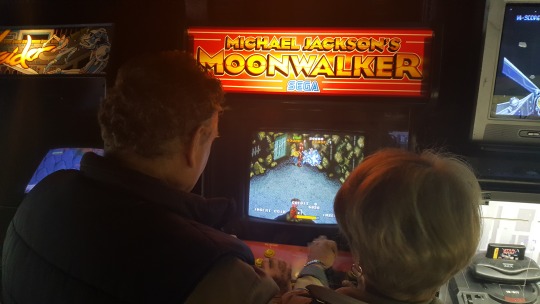
There’s at least a PhD thesis in here
Digital archaeology guru Jeremy Huggett recently reminded us about the need to deal with the historicity of technology: as the workings of our gadgets inexorably disappear into smaller and more efficient packages, we know less about how our devices work, and think little about why they are built the way they are. So break open a few controllers and cartridges to teach the history of computing. We assume a linear progression from worse to better technology on the basis that the invisible hand of the market chose the best products over time. So tell the story of the Sega Dreamcast, recognised for its merits only long after its demise. The market of ideas is always in conflict with the actual market, and real innovation is always pitted against the chance for real profit. Teach the Great Video Game Crash and its mountain of destroyed cartridges; debate the value of excavating the recent past, and what else of theirs will remain to be excavated.
It’s not all about the tech, either. You don’t have to wait for Assassin’s Creed: Cuban Missile Crisis to teach kids about the Cold War and why we’re (still) not playing nice with Russia. You can start with games like Contra and Missile Command and talk about ways in which war found its way even into children’s bedrooms in the 1980s. Maybe have a frank discussion about all those Battlefield games they’re playing now. Play the first ten seconds of Double Dragon to introduce the term ‘toxic masculinity’.
There’s a million ways to sneak learning into a trip to the arcade. Teach the kids how to critically read the artefacts; what could be more archaeological?
More photos here.
Follow us on @AlmostArch
3 notes
·
View notes
Text
Premier League Week 17 Review
Week 17 of the Premier League didn’t had a couple of surprising results, but aside from Everton and Norwich City drawing with Manchester United and Leicester City respectively, it was a boring week for the Premier League. Here are some of the more important headlines to come out of another week of action.
Arsenal’s miserable season continues
What was supposed to be the premier matchup of the weekend between Manchester City and Arsenal turned out to be a one-sided affair. By the 40th minute, Kevin De Bruyne had given Man City a 3-0 lead, enroute to three points. Even with an hour to play, the game was pretty much over. Arsenal had lost to another team position above them in the table.
After the loss, the Gunners have 22 points and are in ninth place. And it’s a valid reflection of how Arsenal have played this season. Arsenal have played seven of the eight teams currently above them in the table. They’ve won zero, drawn three and lost four, for a grand total of three points.
That’s the reason why Arsenal fired manager Unai Emery, and if it continues, will likely be the reason why interim manager Freddie Ljungberg won’t be brought back. There are too many things to fix at Arsenal, and too little time. The club clearly still has visions of qualifying for the Champions League, but it might be smart to push that idea back for a couple of seasons.
There is still talent in Arsenal’s attack with Alexander Lacazette, Pierre-Emerick Aubamayang and Nicolas Pepe. Arsenal even have exciting youth-prospects like Gabriel Martinelli, Bukayo Saka, Emile Smith-Rowe and Joseph Willock, all of whom have made appearances in the Premier League this season.
Aside from that Arsenal lack leadership and defensive integrity. There’s no one in this squad that fits the mold of a captain. This can be seen in the instance where former captain Granit Xhaka was stripped of his captaincy after being booed off the field by his own fans.
Aubamayang has filled-in as captain, but it was almost as if he was given that position just because he’s one of the fans’ most popular players. There are other players like David Luiz, Hector Bellerin and Sokratis Papastathopoulos who have plenty of experience, but none of them really fit the mold to wear the armband.
Then there’s the defending. The aforementioned defenders have been poor this season. But add that to the atrocious play of Sead Kolasinac and Shkodran Mustafi, and Arsenal’s back-line is laughable at best.
All of this won’t be fixed overnight. The prime example that Arsenal should look to is Liverpool. Manager Jürgen Klopp was appointed in the early stages of the 2015/16 season with some of the same problems. It took Klopp a few years before Liverpool were finally able to challenge for titles and win European competitions.
The most important thing for Arsenal and its fans is to be patient. Whoever they hire as their new manager won’t be able to turn this team into title-challengers overnight. It will take multiple transfer windows and a couple of years before Arsenal are competitive again. Let alone able to challenge for silverware.
Meanwhile, this is an important win for Man City. They’re still in third place with 35 points, four points behind second place Leicester City, but they host Leicester on Dec. 21. With a win, Man City could vault into second place and reignite their title defense.
Duncan Ferguson gets replaced with Carlo Ancelotti even after positive results
So far so good for Everton interim manager Duncan Ferguson. Last week Everton showed fight, something they rarely had under former manager Marco Silva, on their way to a 3-1 win over Chelsea. A week later and the Toffees have grinded out another positive result. This time a one-all draw at Manchester United.
With four points in his first two games, Big Dunc has managed his former club out of the relegation zone. An impressive feat considering how languished this squad looked earlier this month. However, on Monday, Ferguson was rewarded for his efforts by being replaced with the recently fired Napoli manager Carlo Ancelotti.
It’s a puzzling move for Everton, especially since Big Dunc has improved what was a poor performing Everton squad. Prior to Ferguson’s appointment, Everton were in the relegation zone. But after two games and four points, the Toffees are in 16th place, three points ahead of the drop. One would think that Everton should stick with Ferguson due to his impressive start, however Everton saw an opportunity to hire a manager with pedigree and jumped on it.
Ancleotti is one of Europe's most decorated managers, which is one reason why he was hired for the job. During his time managing Real Madrid, AC Milan, Bayern Munich, Paris Saint-Germain and Chelsea, Ancelotti has won three Champions Leagues, four league title (one Premier League, one La Liga title, one Bundesliga title and one French Ligue 1 title), along with countless other trophies and managerial awards.
The Italian manager has built a reputation as a manager for premier clubs, so it’s interesting to see him agree to a deal to manage a club stuck in the bottom half of their respective league table. Time will tell if Ancelotti’s appointment will work. The Italian has a busy fixture schedule ahead of him as the Toffees play four Premier League games in 11 days. He will need to relay his tactics t a squad that will be under its third manager in less than a month.
Does anyone want to challenge Liverpool?
League-leaders Liverpool had a poor showing against bottom club Watford on Saturday. But the Reds still managed win 2-0. This meant that the Reds have now amassed a remarkable 49 points from 17 games, winning 16 and drawing just one.
Later that day, Leicester City, who are second in the table, needed a win if they wanted to remain eight points behind the leaders. And three points seemed to be almost automatic for the Foxes as they welcomed second-bottom Norwich City to the King Power Stadium. Afterall, Leicester had won their last eight games in-a-row.
However, Leicester’s winning streak was in jeopardy after their first half against Norwich. If it weren’t for last-ditch defending and poor finishing, the Canaries could have been leading going into halftime. Norwich’s attacking gameplan was simple, but effective. They would take advantage of Leicester's high defensive line and play long balls in behind to their forwards.
Leicester did improve after they conceded in the 26th minute. The Foxes would draw level after a Jamie Vardy header was deflected by Norwich goalkeeper Tim Krul into the back of his own net in the 38th minute. From that point Leicester pressed for the second goal. If it weren’t for Krul’s heroics, and some last-ditch defending from Norwich, Leicester would’ve scored the winning goal. But the game would end in a draw, with each team taking a point.
Although, even after gaining a point, Leicester City remain 10 points behind the leaders Liverpool. Their next league game is on Dec. 21 at Manchester City. The winner of that match will likely be seen as the favorite to challenge Liverpool for the title. But if that game ends in a draw, then the title might be too far out of reach for either team.
Goal of the week: Dan Gosling vs. Chelsea
A lovely bit of ingenuity for goal of the week here. Bournemouth’s Dan Gosling might not have hit this ball the hardest or dribbled past an entire team, but what he did do was no less impressive. The Bournemouth midfielder did well to remain onside, take a good first touch and smartly dink the ball over the keeper. The goal might have gone to video review, but that still doesn't take away from Gosling’s ingenuity.
#Barclays Premier League#Arsenal#Manchester City#Everton#carlo ancelotti#Leicester City#norwich city#bournemouth#soccer#football
0 notes
Text
The Eagles View Golden Tate as a “Playmaker” and Not Necessarily a Slot Receiver
Is Golden Tate the player that puts you over the top? Is he the guy that brings you level with the New Orleans Saints and Los Angeles Rams?
Or –
Is he redundant? Is he another slot receiver on a team that already has Nelson Agholor and Jordan Matthews?
The cop out answer probably falls somewhere in between. Tate is a hell of a player, a YAC monster who can make things happen with the ball in his hands. No, he’s not going to blow the top off of a defense and stretch the field like DeSean Jackson, but you can throw him some dink and dunk five-yard stuff that he’ll turn into 15. He immediately improves the Eagles’ offense.
One thing seems very clear; this is not going to be a dominant running team moving forward. It’s going to be Wendell Smallwood and whatever Doug Pederson does with Josh Adams and Corey Clement. Darren Sproles is a total question mark at this point with the world’s most severe hamstring strain. What you’re seeing here is something similar to what the Patriots do, which is surround Tom Brady with playmakers and just get the ball in their hands. The Eagles’ passing game is going to be even more of an extension of the running game now, with that typical 60/40 pass and run split probably skewing closer to 65/35 moving forward.
Howie Roseman spoke to media after the Birds shipped a third round pick to the Lions yesterday, and he was asked specifically about Tate’s fit in the offense:
Traditionally, he’s excelled in the slot, similar to where WR Nelson Agholor is most effective. Is that a bit of a redundancy or is it more about just adding a good player? (John McMullen)
Roseman: No, you have versatility there. All of those guys can play inside and out. That’s the excitement that our coaches have: you’re not just having one guy lined up in a particular situation and the defense knows that this guy is going to line up there. For us, that’s another part of the excitement of bringing in this guy: his inside-out versatility. It’s the same with Nelly; he has inside-out versatility. Alshon lines up inside and out. Our coaches have a game plan for all of those guys and certainly [for] our tight ends in the middle of the field and the damage that they can do. And we are going to get some guys back [from injury], too.
So we want to be multiple on offense; we want to be a handful for defensive coordinators. This guy is a heck of a player and I think our fans are going to be really excited to see him in Eagles green.
I get it. Versatility is good. You want guys that can do different things. It forces defenses to think and balances your offensive approach.
Philosophically, I guess it just comes down to whether you prefer singularity vs. multiplicity. Do you prefer a position-specific player who does one thing at an elite level (JJ Redick)? Or do you like versatile players who do a few things at an above-average clip (Robert Covington)? I think I prefer the former, though the best teams have a little bit of both. And that’s not to say that Tate can’t be wildly successful here, I just feel like a speedy outside guy would have made more sense for what the Eagles specifically need right now, because they already have a couple of above-average flex receivers.
According to Pro Football Focus, Tate ran 79% of his routes from the slot last season while drawing an “average depth of target of 6.7 yards.” That ranked him 49th of 51 receivers who had at least 75 targets.
So here’s an intriguing chart for you, which shows how each receiver performed in air yards vs. yards after the catch:
Let's try this again.
Two things make up yards per reception: air yards and yards after the catch on the completed pass. Here's every 30+ target WR charted by YAC (x-axis) vs. air yards on receptions (y-axis). It's cluttered, but wanted names in there at the extremes. pic.twitter.com/sJqwjL6ZGI
— JJ Zachariason (@LateRoundQB) January 8, 2018
Tate is way over to the right, which means that he’s relatively low on the air yards total but a total YAC monstrosity. He’s been incredibly effective at converting yards after the catch even though he historically doesn’t get many downfield looks. If you look closely, you can see Agholor in the middle of that chart, with a similar number of air yards but about 300 fewer YAC yards.
What does any of this actually mean for the Eagles and how do they use him?
I’d honestly just run a lot of four and five-wide and spread the ball around, just dink and dunk and throw short bullshit passes and let your weapons do their thing. It’s not like the any Eagles running back is that good at pass blocking anyway, so I’d love to see Carson Wentz come out with some Tom Brady quick release stuff and just sling the rock around the field.
One example:
Classic four receiver set and one of the most common NFL offensive looks. Here you can just move Alshon Jeffery to the outside and sit down Jordan Matthews, who played a lot of wide reps on Sunday.
And a five-wide set could look something like this:
That’s mismatch-city right there, and the things you can do with Ertz, Tate, Agholor, and even Dallas Goedert are very similar to how Seattle had success using empty set against the Eagles last year.
Another easy way to use your glut of inside guys is to just go trips on one side, let Alshon play on the weak outside, and roll out something like this:
Try to cover Ertz, Tate, and Agholor running three different routes out of that set.
The Eagles really have a ton of flexibility here. They’ve been mixing and matching all season long, with Ertz moving around, Agholor moving around, and a lot of plug and play across the line of scrimmage. It isn’t resulting in explosive deep plays, but they’ve had success spreading the ball around and getting different people involved, which really was their bread and butter en route to the Super Bowl last season.
Roseman was also asked about the pursuit of players at other positions, and ended up describing Tate as a “playmaker” without shoe-horning him into a specific category:
What kind of efforts were there to acquire players at other positions? Why wide receiver over running back, defensive back, defensive line and cornerback? (Dave Uram)
Roseman: Yeah, again, as we talked about here, there is no question about the efforts we made here in the last couple of weeks. We just try to find the best player that fits our system and our culture. When we looked around – it’s a supply and demand market and you have to deal what the supply is on the market and then whether you’re willing to pay the price. For us, this is a player who’s a playmaker. You just can’t put him into a position. He’s so good with the ball in his hands. He can play inside and out. He’s got return experience as well. He doesn’t just fit in a box. He can help in a lot of different ways and when we look at our skill positions as a whole, and maybe some of the guys we have coming back, we’re really excited to get going here for the second half of the season.
Tate is a great receiver and a guy who plays with a chip on his shoulder. He really is a perfect fit for this city and I think Eagle fans will really appreciate his approach to the game.
No, he doesn’t fix the defensive lapses and the running game and the issues on the offensive line, but Carson Wentz now has a smorgasbord of dangerous targets to throw the ball to. Should be fun to see how both he and Amari Cooper look when the Birds play the Cowboys next Sunday.
The post The Eagles View Golden Tate as a “Playmaker” and Not Necessarily a Slot Receiver appeared first on Crossing Broad.
The Eagles View Golden Tate as a “Playmaker” and Not Necessarily a Slot Receiver published first on https://footballhighlightseurope.tumblr.com/
0 notes
Text
Producing a Joker Comedy
This is from the May 1914 (!) issue of Movie Pictorial magazine. It’s a review of a movie called The Luck of Hog Wallow Gulch, which I believe is otherwise lost. I’m fascinated by the description of what a movie comedy was supposed to look like in 1914.
Because I am a kind, generous person, most of the article is behind a cut.
Producing a Joker Comedy
By Clarence G. Badger
Have you ever sat in a comfortable — or uncomfortable — plush or wooden chair while the orchestra served its syncopated tunes or the piano its tin pan jumble and, fairly clutching your sides, watched the antics of the joker actrsn performing their ridiculous burlesques on the screen?
If you have, it is equally certain yon have experiences that delicious sensation of thankfulness that your person, at least, was secure; that you, yourself, were in no danger of being spattered by the amateur paper hanger who was demonstrating his prowess by decorating a luxurious drawing room from end to end with great gobs of sticky paste: that the burst water pipe- could not deluge you, no matter haw long the plumber delayed: that the lunatic barber could not reach you with his deadly weapon; that back-breaking falls and elbow-skinning slides, pitched mud battles waged waist deep In ooze, or any one of a hundred other breathtaking and beauty-destroying situations were utterly foreign to your way of life.
Director Allen Curtis misses no situation or location that can be used in the scheme of a comedy. His eyes are open to every possibility. For instance: when the big storm and subsequent flood which broke over the Universal ranch near Los Angeles recently — and incidentally washed out its roadway for half a mile--had subsided. Mr- Curtis at once saw an opportunity in the mud wallows formed by the receding waters. He said to his scenario man:
"Here is mud. Now, build me a story around it. I don't care what it is. Just so the mud flies. Don't forget, the mud must fly!"
He got what be wanted. And you can see it all in "The Luck of Hog Wallow Gulch." The story is this: Arrives the wealthy tenderfoot in Hog Wallow Gulch intent on buying a gold mine. He is taken in tow by Mongrel Mike {Max Asher), who directs him to Adam Crook (Ralph McComas), a dealer in "salted" mines. Mongrel Mike then does the dirty work for Adam Crook by "salting" a mine with wonderful gilt pebbles.
The sale is about to be concluded when the party is broken up by a big black bear who at once singles out Adam Crook — McComas really would make a choice morsel for a bear — and after a terrific chase captures him. The inevitable--in burlesque--happens. The last you see of Adam Crook is his fleshless bones being gnawed clean of their last particle of gristle by Brother Bruin.
Then Prospector Bill (William Franey), who dearly loves, nay. lives on, whisky of the cayenne brand, discovers the salted mine and, being In a slightly pheazed condition, mistakes the gilded pebbles for the real thing, and carries home a sackful to his daughter, Alicia (Louise Fazenda). But Prospector Bill has been trailed to his cabin by Terrible Dink (Bob Vernon) and his band of cut-throats, who rob Bill of the nuggets and carry away Alicia to their den besides.
The wealthy tenderfoot (San KaufmanJ), the innocent cause of all the trouble, discovering the adorable Alicia in the clutches of the bandits, rushes to her rescue with a box of dynamite. Terrible Dink makes a wild get-away to escape the tenderfoot, clinging ail the while to the sack of nuggets, with the result that he is caught in the stick mire of a mud wallow which he is frantically trying to cross. The tenderfoot, close at bis heels and carrying the box of dynamite with the fuse already lit, narrowly escapes being mired, too, and to save himself is obliged to abandon the dynamite, just beside the desperado struggling wildly in the grip of the relentless glue-tike mud, which holds him tightly.
The explosion comes!
High into the air Terrible Dink is hurled, still clutching the precious sack, and down he comes again with a mighty splash! The glittering nuggets are scattered far and wide over the mud hole. And down come the rescuing bandits and begin to search for the nuggets.
This peculiar action of the cut-throat gang ia witnessed by Mongrel Mike, and at once he imagines a gold strike. Wild with excitement, he spreads the news, and the inhabitants of the Gulch rush in frantic haste to tbe spot. The bandits, of course, resent this invasion and--at last--a glorious mud battle begins. The apposing factions face each other, waist deep in the mire, at first flinging the mud in handfuls as one might throw snow balls. But very soon they close in and the fighting becomes rough and tumble, with the combatants rolling about in the ooze.
Then comes the breakaway, and the wild rush to the assay office to dispose of the nuggets. What follows when they discover that their nuggets are only gilded pebbles . . . Words fail, but the film tells it alL
Mr. Curtis, the director, and O. G. Hill, tbe camera man, must not be forgotten. In producing this picture they had to be as game as the performers, wade into the wallow, and take their share of the flying gobbets. They almost seemed to enjoy it.
Well, as a matter of fact, everyone enjoyed it. Who wouldn't? It wasn't work at all. It was play.
0 notes